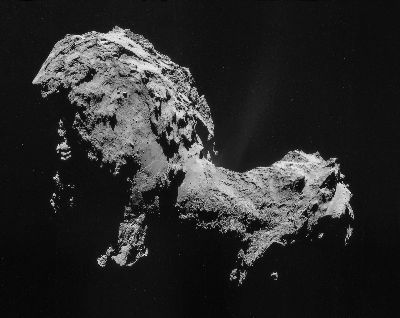by Larry
November, 2014The Rosetta Mission
The Rosetta Mission began over ten years ago, on 3/2/04, and traveled over 6.4 billion kilometers (roughly 3.4 billion miles) to catch Comet 67P/Churyumov–Gerasimenko, along the way also making close encounters with a couple asteroids, 2867 Steins and 21 Lutetia, photographs of which were beamed earthward. The Philae lander mission is over for the time being, the craft having functioned, taken pictures, and done research for about 64 hours on the comet surface before losing battery power. Though it has solar panels for recharging, they could not be correctly deployed due to the location and angle of the lander once it had achieved its final touchdown. As the comet continues its orbit and gets closer to the sun, however, it is hoped that more light will be able to reach the panels so that battery power may be restored, further experiments be conducted from right on the surface, and key info be relayed back to those collecting and monitoring it at the European Space Agency (ESA). Many pictures and much other data have already been obtained from the Rosetta scientific effort. Meanwhile, the overall mission is far from over. Rosetta is being maneuvered, realigned in its orbit to be cautiously a bit farther from the comet. As Comet 67P/Churyumov–Gerasimenko gets closer to the sun, it is likely to begin sending jets of gas and ice or rock debris into space, much of it forming a visible tail out behind (away from the sun). From the safer orbital distance, perhaps about 30 kilometers (approximately 16 miles) above the comet surface, Rosetta can continue to take photographs and experimental measurements, sending the results back to ESA scientists. Via both the Rosetta Mission and its Philae lander, ESA researchers hope to:
If interested in the many cool developments of the Rosetta Mission, one can follow along and get abundant background info, plus see great photo images, at the ESA site: Rosetta. Readers may also enjoy watching a special PBS video on the Rosetta Mission: To Catch a Comet, which premiered on 11/19/14. |
